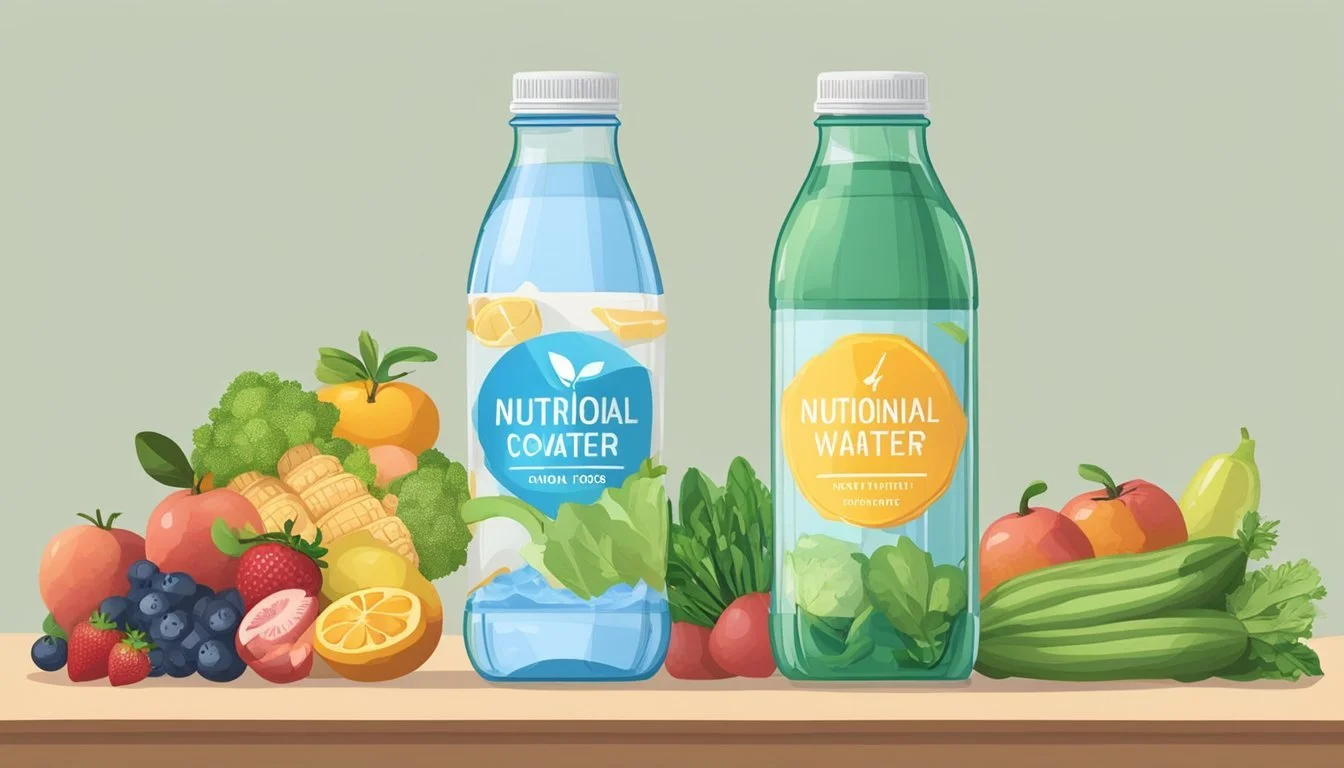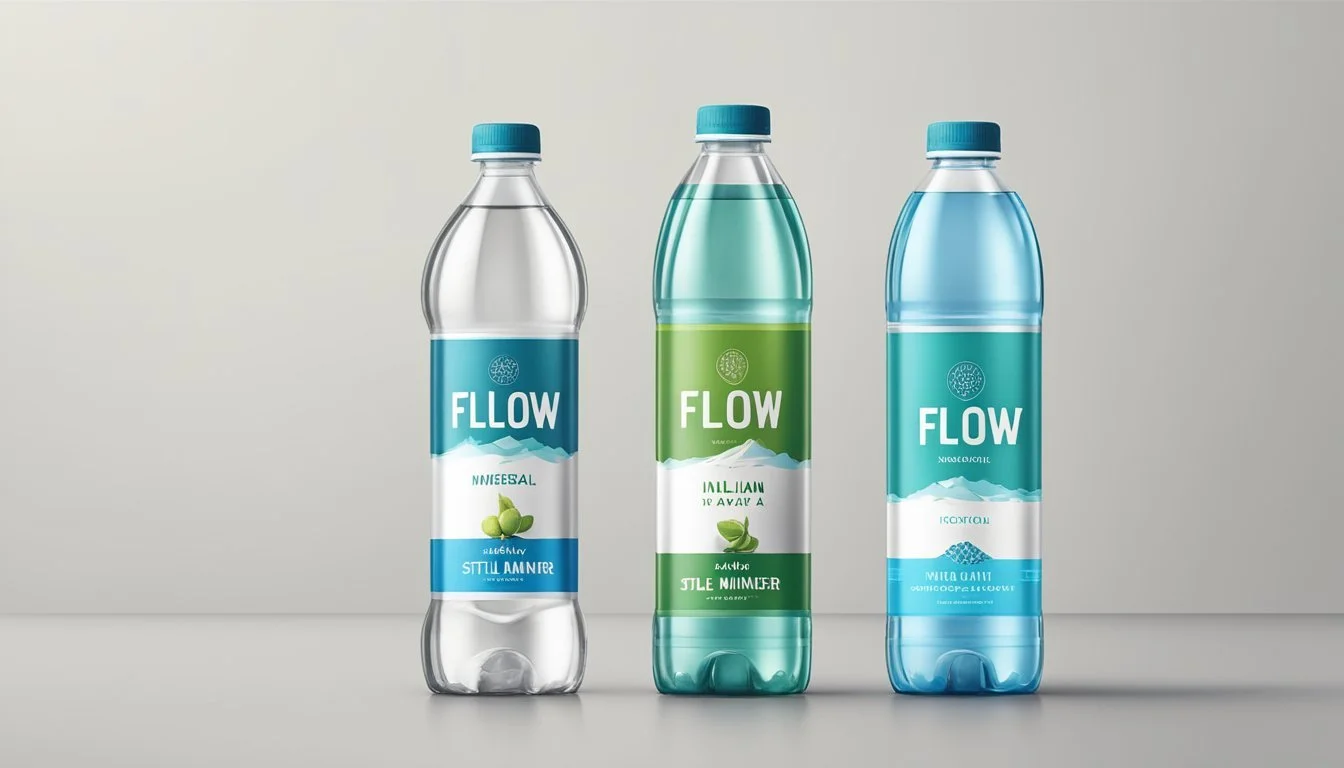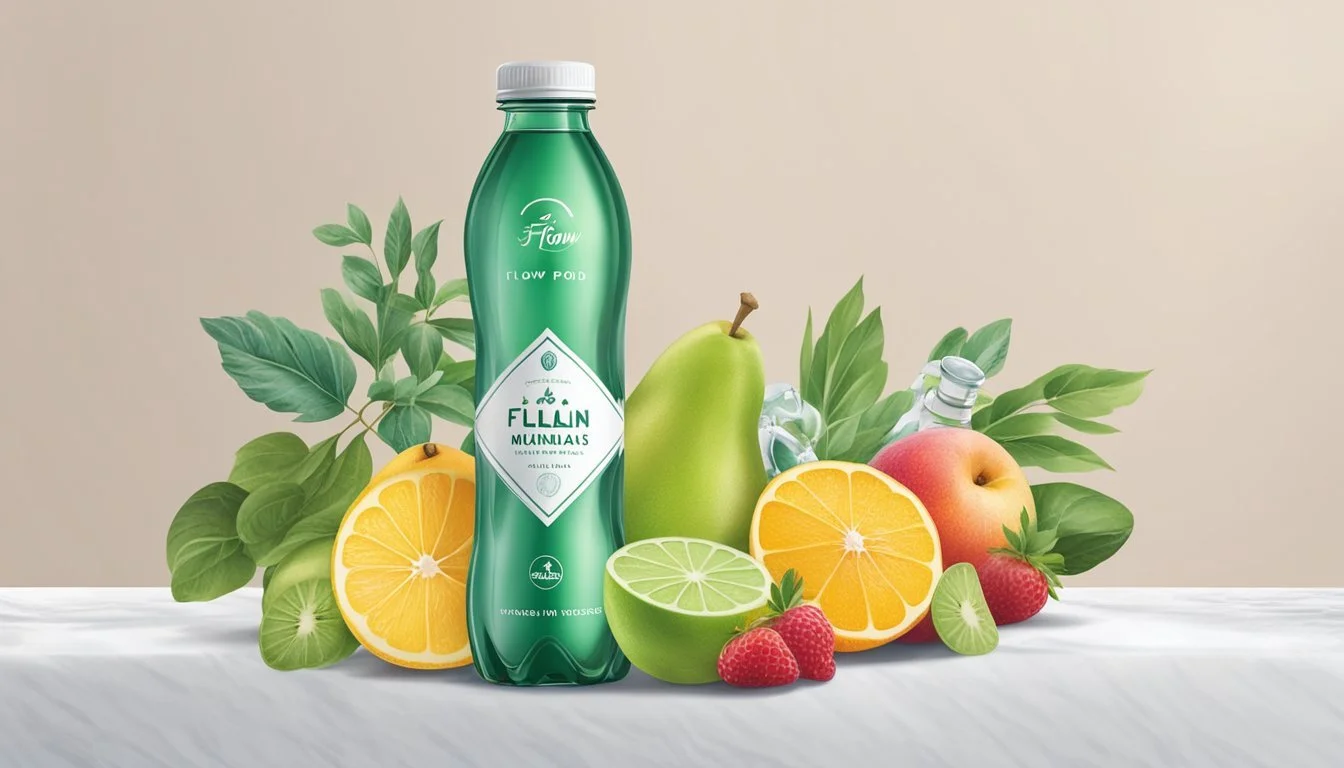Flow vs. Whole Foods Italian Still Mineral Water
Which Bottled Water Reigns Supreme?
When choosing between Flow and Whole Foods Italian Still Mineral Water, consumers often consider factors like taste, mineral content, and environmental impact. Flow is known for its alkaline pH and eco-friendly packaging, making it a popular choice for those who prioritize both health and sustainability. By contrast, Whole Foods Italian Still Mineral Water offers a balanced mineral profile and a crisp, refreshing taste, but it is somewhat acidic due to its lower pH.
Flow's water is sourced from natural springs in Canada, which provides it with unique mineral properties that are often touted for their health benefits. Its use of Tetra Pak packaging, primarily made from renewable resources, sets it apart in the bottled water market. On the other hand, Whole Foods Italian Still Mineral Water, bottled at the La Galvanina Spa Source in Italy, carries the traditional appeal of European mineral waters and is sold under the trusted Whole Foods brand.
Choosing the better bottled water between the two often comes down to personal preference and specific needs. For those looking for an alkaline option with environmentally friendly packaging, Flow stands out. For a classic European mineral water experience with a well-rounded taste, Whole Foods Italian Still Mineral Water is a solid choice.
Overview of Flow and Whole Foods Italian Still Mineral Water
Flow and Whole Foods Italian Still Mineral Water are both notable brands in the bottled water market. Their profiles and sources of origin make them unique choices for consumers looking for purity and quality.
Brand Profiles
Flow: Flow is known for its naturally alkaline spring water with a pH of 8.1. It is marketed as a premium water brand with eco-friendly packaging. The company emphasizes sustainability and health benefits, positioning itself in the higher-end segment of the bottled water market.
Whole Foods Italian Still Mineral Water: Whole Foods offers this water as a private label product, ensuring quality and affordability. This water is bottled at the La Galvanina Spa Source in Rimini, Italy, and boasts a pure mineral composition. Whole Foods markets it as a natural option for those seeking a balance of essential minerals.
Source and Origin
Flow: The water for Flow is sourced from protected springs in North America. These are naturally occurring, protected aquifers, ensuring the water's purity and mineral content remain intact. The company highlights the untouched nature of these springs, which helps maintain a consistent alkaline level.
Whole Foods Italian Still Mineral Water: This water originates from the La Galvanina Spa Source in Rimini, Italy. Bottled in a region renowned for its high-quality mineral waters, it reflects Italy's long tradition of producing fine bottled waters. The source's mineral composition supports the water's marketed health benefits, making it a prominent choice among consumers seeking authenticity.
Both brands focus on quality and purity, providing unique benefits based on their distinct sources and marketing strategies.
Health and Hydration
Both Flow and Whole Foods Italian Still Mineral Water provide unique health benefits due to their distinct mineral compositions. Key factors to consider include mineral content and hydration support.
Mineral Content and Health Benefits
Minerals like calcium, magnesium, potassium, and sodium are essential for various bodily functions. Flow water is known for its rich mineral profile, particularly in calcium and magnesium. Calcium supports bone health, while magnesium is crucial for muscle function and energy production.
On the other hand, Whole Foods Italian Still Mineral Water offers a balanced blend of minerals, with a focus on purity and low sodium content. This can be beneficial for individuals monitoring their sodium intake.Potassium in this water helps in maintaining healthy blood pressure levels. The distinct mineral compositions of these waters can influence personal preferences and specific health needs.
Hydration and Well-Being
Proper hydration is vital for overall well-being, impacting everything from cognitive function to physical performance. Flow water’s high mineral content ensures efficient hydration and electrolyte balance, which can benefit active individuals. The alkaline nature of Flow water, with a pH level around 8.1, may also support better hydration and recovery.
Whole Foods Italian Still Mineral Water, sourced from pristine springs, is known for its clean, refreshing taste, making it easier to drink adequate amounts throughout the day. Its composition suits those who prefer a milder mineral presence while still achieving effective hydration. Both waters can immensely contribute to daily water intake, supporting various aspects of health and well-being.
Quality and Purity Assessment
When choosing between Flow and Whole Foods Italian Still Mineral Water, quality and purity are critical factors to consider.
Mineral Water vs. Tap Water
Flow and Whole Foods Italian Still Mineral Water are both mineral waters, but many bottled waters in the U.S. are essentially tap water. Studies show nearly 64% of bottled water in America is just tap water with varying contaminants.
Mineral Water:
Flow: Sourced from natural springs, maintaining high mineral content.
Whole Foods Italian Water: Comes from Italian sources renowned for purity and unique mineral compositions.
Tap Water:
May contain 8 different contaminants, including caffeine, acetaminophen, fertilizers, and solvents.
Bottled tap water lacks the natural minerals found in mineral water.
Safe to Drink: Testing for Chemicals
Safety involves rigorous testing for substances like PFAS, arsenic, and lead. Consumer Reports detected toxic chemicals in several popular brands, including carbonated ones.
Testing Results:
Flow: Rigorous testing shows minimal chemical presence, with low PFAS levels.
Whole Foods Italian Water: Testing revealed slightly acidic pH but emphasized the water's high purity and low TDS (150-200).
Health experts stress verifying the water source and testing reports to ensure no harmful chemicals are present, ensuring the bottled water is safe to drink.
Taste and Texture Experience
Flow and Whole Foods Italian Still Mineral Water both offer distinct sensory experiences characterized by their unique flavor profiles and textures.
Flavor Profiles
Flow offers a naturally alkaline water with a smooth, clean taste. This brand sources water from natural springs, ensuring no artificial additives affect the natural flavor.
Whole Foods Italian Still Mineral Water, sourced from Italy, has a slightly mineral-rich profile. It features a balanced taste, making it suitable for pairing with various foods.
While Flow has a subtle sweetness, Whole Foods water is more neutral, without any overpowering mineral notes. Each offers a different, yet equally pleasant, flavor experience.
Carbonation and Mouthfeel
Flow is a still water, meaning it lacks carbonation. Its mouthfeel is smooth and soft, providing a refreshing experience without any of the fizziness found in sparkling waters.
Whole Foods Italian Still Mineral Water is also still, boasting a silky texture that goes down easily. The absence of carbonation makes it gentle on the palate.
Though neither water is carbonated, their unique sources impart distinct mouthfeels. The streamlined effervescence in Flow contrasts subtly yet significantly with the delicate texture of Whole Foods water.
Nutritional Content and Diet
Both Flow and Whole Foods Italian Still Mineral Water offer significant nutritional benefits, particularly when it comes to maintaining a balanced diet and supporting digestive health.
Role in a Balanced Diet
Flow Water contains essential minerals such as calcium and magnesium. These minerals contribute to bone health and muscle function. With zero calories and no added sugars, it aligns well with dietary guidelines, including the Mediterranean diet, which emphasizes whole foods and minimal processed items.
Whole Foods Italian Still Mineral Water also offers key minerals. It is dairy-free and suitable for various dietary preferences. The inclusion of essential minerals makes it a suitable choice for those seeking to meet their daily nutritional requirements through their water consumption.
Contribution to Digestive Health
Flow Water, with its balanced mineral content, including high levels of magnesium, can aid in digestive processes. Magnesium helps in muscle contractions, which is essential for regular bowel movements. This can be particularly beneficial for individuals with digestive issues.
Whole Foods Italian Still Mineral Water contains sodium, which plays a role in maintaining fluid balance and nerve function—both crucial for digestion. The natural mineral composition supports the digestive system and can be a soothing option for sensitive stomachs. This makes it a useful addition to daily hydration plans focused on digestive health.
By integrating these waters into their daily routines, individuals can benefit from the supportive role they play in both their overall nutrition and specific digestive wellness.
Environmental Impact and Sustainability
When comparing the environmental impact and sustainability of Flow and Whole Foods Italian Still Mineral Water, various factors must be considered.
Materials used in packaging play a significant role. Flow's packaging uses Tetra Pak cartons, which are designed to be recyclable and are made from FSC-certified paperboard. In contrast, Whole Foods Italian Still Mineral Water typically uses plastic bottles.
Path to sustainability also includes production and distribution processes. Flow claims to use renewable energy sources in its production processes, aiming to minimize the carbon footprint. Whole Foods' packaging, primarily plastic, has a larger carbon footprint due to the energy-intensive processes involved in plastic production.
A life-cycle analysis reveals substantial differences. Bottled water has an environmental impact 3,500 times greater than tap water, and plastic bottles significantly contribute to this figure due to high energy usage and poor recyclability rates.
Sustainability efforts also extend to corporate practices. Flow emphasizes a commitment to sustainability through partnerships with environmental organizations and transparent reporting on its environmental impact. Whole Foods has sustainability initiatives, but the reliance on plastic undermines these efforts.
The products' environmental footprint shows that tap water has the lightest impact, and reusable containers reduce it further if used consistently. Bottled water, particularly in plastic bottles, produces more carbon dioxide emissions compared to reusable alternatives.
Brand Packaging Material Carbon Footprint Sustainability Initiatives Flow Tetra Pak Cartons Lower Renewable energy, partnerships with environmental organizations Whole Foods Italian Still Mineral Water Plastic Bottles Higher Some initiatives, but reliance on plastic
Analyzing these factors highlights the critical distinctions in environmental impact and sustainability between Flow and Whole Foods Italian Still Mineral Water. Each brand’s packaging material and sustainability practices shape its overall environmental footprint.
Packaging and Availability
The differences and unique features of Flow and Whole Foods Italian Still Mineral Water are best understood by looking at their packaging options and where they are available for purchase.
Bottle Sizes and Materials
Flow is known for offering eco-friendly packaging, using Tetra Pak containers. These containers are primarily made from paperboard, which is renewable and results in a lower carbon footprint compared to plastic bottles. Flow is typically available in sizes such as 500 ml and 1 liter.
Whole Foods' Italian Still Mineral Water is packaged in traditional plastic bottles. The water is available in various sizes, with 33.8 fl oz (roughly 1 liter) being a popular choice. The labeling emphasizes that the product contains mineral water sourced from Italy.
Retail Presence and Accessibility
Flow is widely available both online and in physical grocery and health food stores. Its distribution network includes major retail chains and specialty stores, making it easily accessible to consumers. Online availability also means that Flow can be conveniently ordered for home delivery.
Whole Foods Italian Still Mineral Water is predominantly found in Whole Foods Market stores. It may not be as widely available in other retail outlets. Whole Foods frequently offers promotions and discounts on this product, though the prices can vary. Shoppers can also find this brand as part of Whole Foods' online shopping platform for added convenience.
Economic Considerations
When choosing between Flow and Whole Foods Italian Still Mineral Water, understanding the economic factors such as price points and brand market performance is crucial. This section explores key details about the cost and economic influence of both brands.
Price Comparison
Prices for bottled water can vary significantly depending on brand and size. Flow water typically ranges from $1.50 to $2.50 for a 500 ml bottle. In comparison, Whole Foods Italian Still Mineral Water, specifically the 33.8 fl oz (approximately 1 liter), ranges around $1.00 to $1.50 per bottle.
Whole Foods also tends to offer promotions and discounts that can further reduce the cost, especially for in-store purchases.
Brand Value and Market Performance
Flow water, known for its eco-friendly, recyclable packaging and ethical marketing campaigns, appeals to environmentally conscious consumers. This has helped the brand gain a strong foothold in the market.
Whole Foods Italian Still Mineral Water benefits from being part of Whole Foods Market's extensive retail network, ensuring consistent availability and consumer trust. The brand maintains a steady market presence, aided by Whole Foods' reputation for quality and natural products.
Both brands have distinct advantages when considering the economic landscape, with Flow focusing on sustainability and Whole Foods leveraging its retail strength.
Conclusion
When comparing Flow and Whole Foods Italian Still Mineral Water, there are several key differences to highlight.
Flow offers a balanced mineral composition with a slightly alkaline pH, catering to those who seek hydration with a premium twist. Its eco-friendly packaging appeals to environmentally conscious consumers. Flow's smooth taste and added electrolytes support active lifestyles.
Whole Foods Italian Still Mineral Water presents a more traditional option. Sourced from Rimini, Italy, it has a mineral profile that is neutral and familiar. This water is often preferred for its purity and straightforward approach to hydration.
Both brands have unique selling points:
Flow:
pH: Slightly Alkaline
Packaging: Eco-Friendly
Ideal for: Active Lifestyles
Whole Foods Italian Still:
pH: Neutral
Source: Rimini, Italy
Ideal for: Traditional Hydration
Consumers choosing between these two should consider their personal preferences and hydration needs. Whether prioritizing sustainability, taste, or mineral content, both options provide high-quality hydration solutions.
More About Flow
More About Whole Foods Italian Still Mineral Water
Whole Foods Italian Still Mineral water vs HFactor: Which Bottled Water is Better?
Acqua Pana vs Whole Foods Italian Still Mineral water: Which Bottled Water is Better?
Antipodes vs Whole Foods Italian Still Mineral water: Which Bottled Water is Better?
Aqua Carpatica vs Whole Foods Italian Still Mineral water: Which Bottled Water is Better?
Aquafina vs Whole Foods Italian Still Mineral water: Which Bottled Water is Better?
Arrowhead vs Whole Foods Italian Still Mineral water: Which Bottled Water is Better?
Bai vs Whole Foods Italian Still Mineral water: Which Bottled Water is Better?
Boxed Water vs Whole Foods Italian Still Mineral water: Which Bottled Water is Better?
Castle Rock vs Whole Foods Italian Still Mineral water: Which Bottled Water is Better?
Core Hydration vs Whole Foods Italian Still Mineral water: Which Bottled Water is Better?
Deer Park vs Whole Foods Italian Still Mineral water: Which Bottled Water is Better?
Erewhon vs Whole Foods Italian Still Mineral water: Which Bottled Water is Better?
Essentia vs Whole Foods Italian Still Mineral water: Which Bottled Water is Better?
Eternal vs Whole Foods Italian Still Mineral water: Which Bottled Water is Better?
Ethos vs Whole Foods Italian Still Mineral water: Which Bottled Water is Better?
Evian vs Whole Foods Italian Still Mineral water: Which Bottled Water is Better?
Fiji vs Whole Foods Italian Still Mineral water: Which Bottled Water is Better?
Hawaii Volcanic vs Whole Foods Italian Still Mineral water: Which Bottled Water is Better?
Hawaiian Springs vs Whole Foods Italian Still Mineral water: Which Bottled Water is Better?
Ice Mountain vs Whole Foods Italian Still Mineral water: Which Bottled Water is Better?
Icelandic Glacial vs Whole Foods Italian Still Mineral water: Which Bottled Water is Better?
Just Water vs Whole Foods Italian Still Mineral water: Which Bottled Water is Better?
LIFEWTR vs Whole Foods Italian Still Mineral water: Which Bottled Water is Better?
Liquid Death vs Whole Foods Italian Still Mineral water: Which Bottled Water is Better?
Mananalu vs Whole Foods Italian Still Mineral water: Which Bottled Water is Better?
Nestle Pure Life vs Whole Foods Italian Still Mineral water: Which Bottled Water is Better?
Origin vs Whole Foods Italian Still Mineral water: Which Bottled Water is Better?
Ozarka vs Whole Foods Italian Still Mineral water: Which Bottled Water is Better?
Path vs Whole Foods Italian Still Mineral water: Which Bottled Water is Better?
Penta vs Whole Foods Italian Still Mineral water: Which Bottled Water is Better?
Perrier vs Whole Foods Italian Still Mineral water: Which Bottled Water is Better?
Poland Spring vs Whole Foods Italian Still Mineral water: Which Bottled Water is Better?
Purely Sedona vs Whole Foods Italian Still Mineral water: Which Bottled Water is Better?
San Pellegrino vs Whole Foods Italian Still Mineral water: Which Bottled Water is Better?
Smartwater vs Whole Foods Italian Still Mineral water: Which Bottled Water is Better?
Solan de Cabras vs Whole Foods Italian Still Mineral water: Which Bottled Water is Better?
Starkey vs Whole Foods Italian Still Mineral water: Which Bottled Water is Better?
Tahoe vs Whole Foods Italian Still Mineral water: Which Bottled Water is Better?
Topo Chico vs Whole Foods Italian Still Mineral water: Which Bottled Water is Better?
Tru Alka vs Whole Foods Italian Still Mineral water: Which Bottled Water is Better?
Volvic vs Whole Foods Italian Still Mineral water: Which Bottled Water is Better?
Voss vs Whole Foods Italian Still Mineral water: Which Bottled Water is Better?
Waiakea vs Whole Foods Italian Still Mineral water: Which Bottled Water is Better?
Whole Foods Italian Still Mineral water vs 1907water: Which Bottled Water is Better?
Whole Foods Italian Still Mineral water vs 7-Select: Which Bottled Water is Better?
Whole Foods Italian Still Mineral water vs Action: Which Bottled Water is Better?
Whole Foods Italian Still Mineral water vs Alkaline88: Which Bottled Water is Better?
Whole Foods Italian Still Mineral water vs Augi: Which Bottled Water is Better?
Whole Foods Italian Still Mineral water vs Big Chill: Which Bottled Water is Better?
Whole Foods Italian Still Mineral water vs Big Win: Which Bottled Water is Better?
Whole Foods Italian Still Mineral water vs Blk: Which Bottled Water is Better?
Whole Foods Italian Still Mineral water vs BodyArmor: Which Bottled Water is Better?
Whole Foods Italian Still Mineral water vs Cascade Mountain: Which Bottled Water is Better?
Whole Foods Italian Still Mineral water vs CBD Living: Which Bottled Water is Better?
Whole Foods Italian Still Mineral water vs Cirro: Which Bottled Water is Better?
Whole Foods Italian Still Mineral water vs Crystal Geyser: Which Bottled Water is Better?
Whole Foods Italian Still Mineral water vs Crystal Lake: Which Bottled Water is Better?
Whole Foods Italian Still Mineral water vs Dasani: Which Bottled Water is Better?
Whole Foods Italian Still Mineral water vs Defy: Which Bottled Water is Better?
Whole Foods Italian Still Mineral water vs Essence pH10: Which Bottled Water is Better?
Whole Foods Italian Still Mineral water vs Kirkland Signature: Which Bottled Water is Better?
Whole Foods Italian Still Mineral water vs Kroger: Which Bottled Water is Better?
Whole Foods Italian Still Mineral water vs Open Water: Which Bottled Water is Better?
Whole Foods Italian Still Mineral water vs Ophora: Which Bottled Water is Better?
Whole Foods Italian Still Mineral water vs Proud Source: Which Bottled Water is Better?
Whole Foods Italian Still Mineral water vs Pure Life: Which Bottled Water is Better?
Whole Foods Italian Still Mineral water vs Ramona: Which Bottled Water is Better?
Whole Foods Italian Still Mineral water vs Refreshe: Which Bottled Water is Better?
Whole Foods Italian Still Mineral water vs Richard's Rainwater: Which Bottled Water is Better?
Whole Foods Italian Still Mineral water vs Simple Truth: Which Bottled Water is Better?
Whole Foods Italian Still Mineral water vs Skyra: Which Bottled Water is Better?
Whole Foods Italian Still Mineral water vs Talking Rain AQA: Which Bottled Water is Better?
Whole Foods Italian Still Mineral water vs The Well: Which Bottled Water is Better?
Whole Foods Italian Still Mineral water vs Weird Water: Which Bottled Water is Better?
Whole Foods Italian Still Mineral water vs Whole Foods 365: Which Bottled Water is Better?
Whole Foods Italian Still Mineral water vs Zenwtr: Which Bottled Water is Better?
Zephyrhills vs Whole Foods Italian Still Mineral water: Which Bottled Water is Better?









